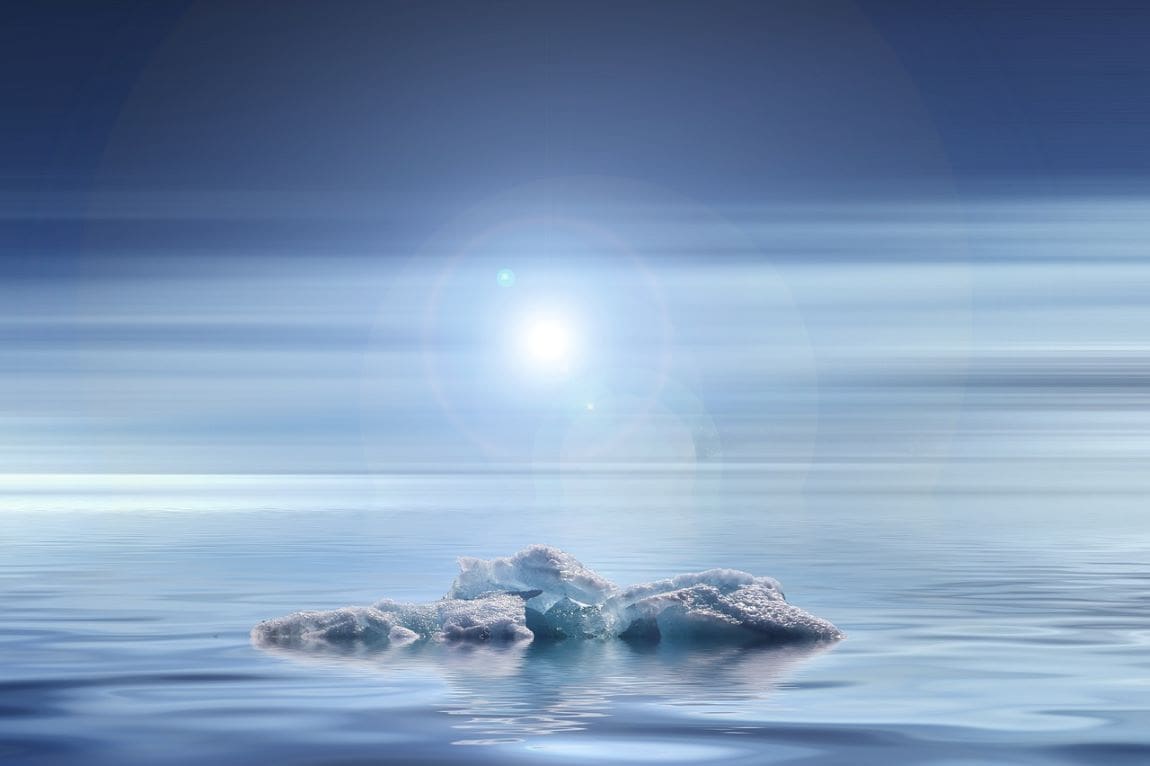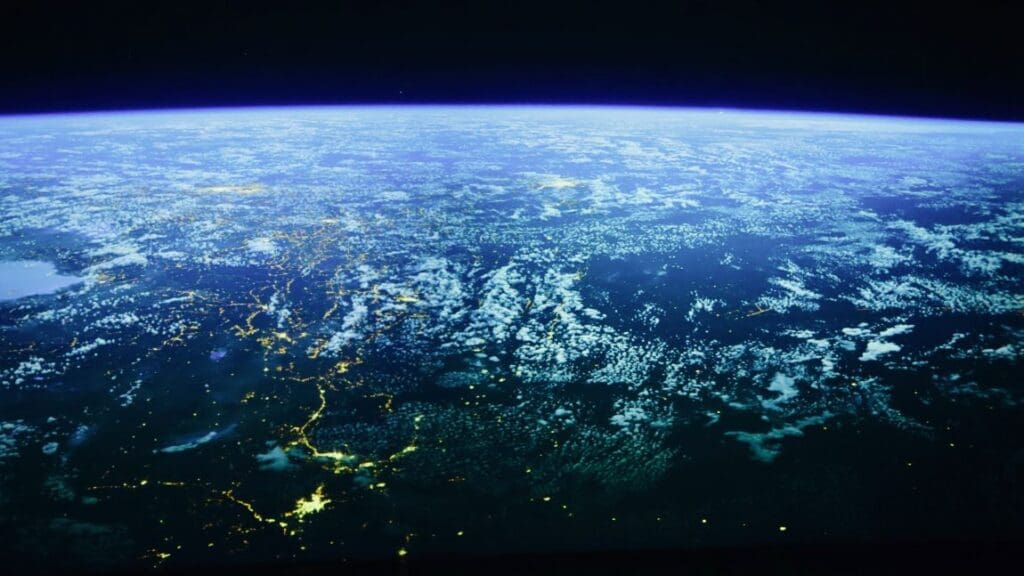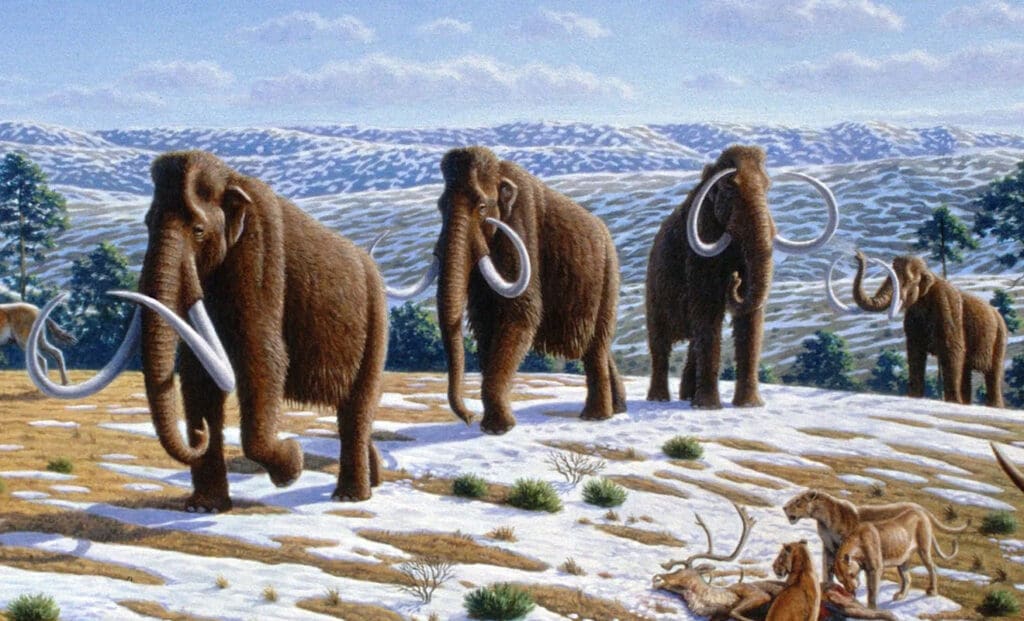Explore the latest insights from top science journals in the Muser Press daily roundup, featuring impactful research on climate change challenges.
In brief:
Resilient algae may speed up Greenland ice melt
It’s May. The sun is up and the heat from that distant star can finally be felt as a warm tingling sensation on the skin. The snow starts to melt. Flowers and plants break through the ice gasping for light. And the algae living on the ice sheet blooms, darkening the ice. It’s been like that for thousands of years. But soon this may change.
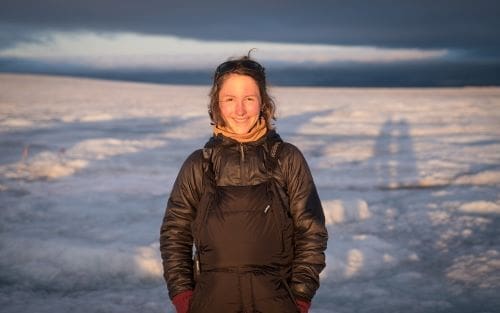
Spring comes earlier and earlier each year because of climate change and this could enable the algae to colonize larger and larger areas of the ice. The algae contains brown pigment which darkens the ice. This, in turn, makes the ice melt faster, as its ability to reflect the sun diminishes when it’s darkened. This has been known by polar researchers for quite some time. But it was believed that the algae has limited capabilities of colonizing the ice, because of the lack of nutrients in this ice desert. Until now.
New results published in Nature Communications show the algae are able to live off very few nutrients. And that they are able to store and save up energy. This makes it possible for them to colonize much more of the ice sheet than previously thought.
Laura Halbach, who recently got her Ph.D. degree at the Department of Environmental Science at Aarhus University, together with her research team is behind the discovery. Now a postdoctoral researcher at the Max Planck Institute in Bremen, she continues unravelling the mysteries of the arctic ecosystems.
“My main goal with the trip to Greenland was to understand the mechanisms of the algae bloom formations. With new methods I was able to, as the first researcher ever, to measure the activity of single algae cells from the Greenland Ice Sheet. This led to the discovery of their ability to live off very few nutrients and to store up energy,” she says.
The life of an ice alga
- Ice algae are small single celled organisms. Elongated, brownish and ellipse shaped.
- They thrive on ice surfaces around the world. They have been found on the Greenland ice sheet, in the Alps as well as on glaciers in the Himalayas and Alaska.
- Like plants the ice algae releases oxygen through photosynthesis and produces organic molecules. It needs sunlight, water and CO2 as well as small amounts of phosphorus, nitrogen and carbon to survive.
- During spring and summer the ice algae blooms creating large patches of darkened ice.
The ice sheet is teeming with life
Not that many years ago the Greenland ice sheet was thought of as a frozen desert. Desolate and almost devoid of life. But since the first researchers from Aarhus University and GFZ Helmholtz Center for Geosciences in Germany arrived in 2020, this has gradually changed. Now we know that the ice is teeming with microbial life.
Expedition after expedition has revealed more and more of the secret life of the ice algae. One major breakthrough was the discovery that the algae is not alone. A whole ecosystem of microorganisms live on the ice: Bacteria, fungi and even viruses.
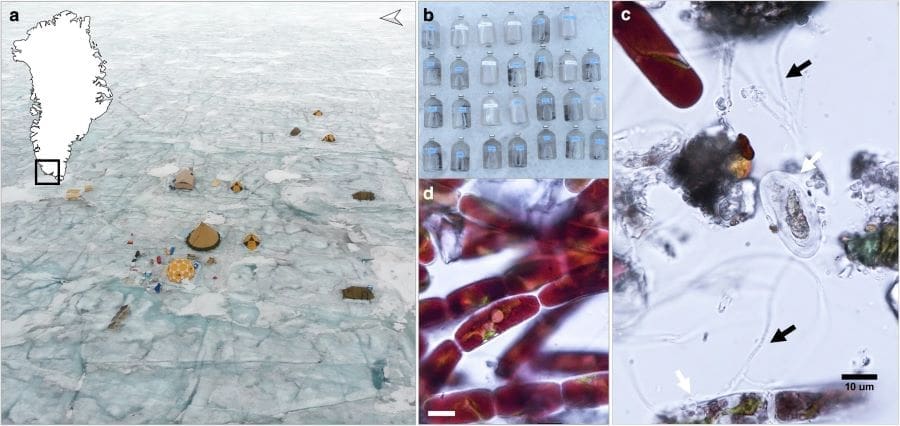
But this made it hard to do specific studies of the algae. When researchers scrape off samples of blackened ice, the petri dishes are filled with whole ecosystems. Until now the researchers have only been able to manipulate and test hypotheses on all of the microorganisms at once. And that was what Laura Halbach set out to change.
“If you melt a piece of the surface ice, you see these dark pigmented algae. But there are many organisms in the sample as well as snow-algae, other eukaryotic algae, bacteria and fungi.”
“What is commonly done is to incubate the whole community. You give them a nutrient and measure the uptake in the whole community. But then it remains unclear what role the different organisms play.”
Zooming in on single cells
Because Laura Halbach was interested in understanding the role of the ice algae in the ecosystem on the ice, she couldn’t just isolate them. Instead, she fed the whole ecosystem marked nutrients. Minuscule isotopic traces that can be recognized by a machine called a mass spectrometer.
“You could say that we kind of labeled the food we gave them. This enabled us to see who ate what. Combined with a machine called SIMS, which is extremely precise, we were able to measure the nutrient uptake of single cells,” Laura Halbach explains.
The data from the machine showed that the algae effectively consumed the small amounts of nutrients available – and that they had some stored as well. Something that was completely unknown to the researchers.
“They are very efficient in taking up the limited nutrients on the ice. Furthermore we discovered that they have the capability of storing phosphorus, which is crucial for their metabolism.”
Phosphorus is very limited on the ice. Some research suggests that it comes from local rocks containing minerals with phosphorus in them. When the rocks are turned into mineral dust by erosion, it’s scattered across the ice and becomes available to the algae.
A game changer in understanding ice algae
Because the ice algae are able to store phosphorus, they can potentially colonize areas of the ice with very limited amounts of these nutrients. Thus the darkening of the ice might spread to larger areas than was previously thought possible.
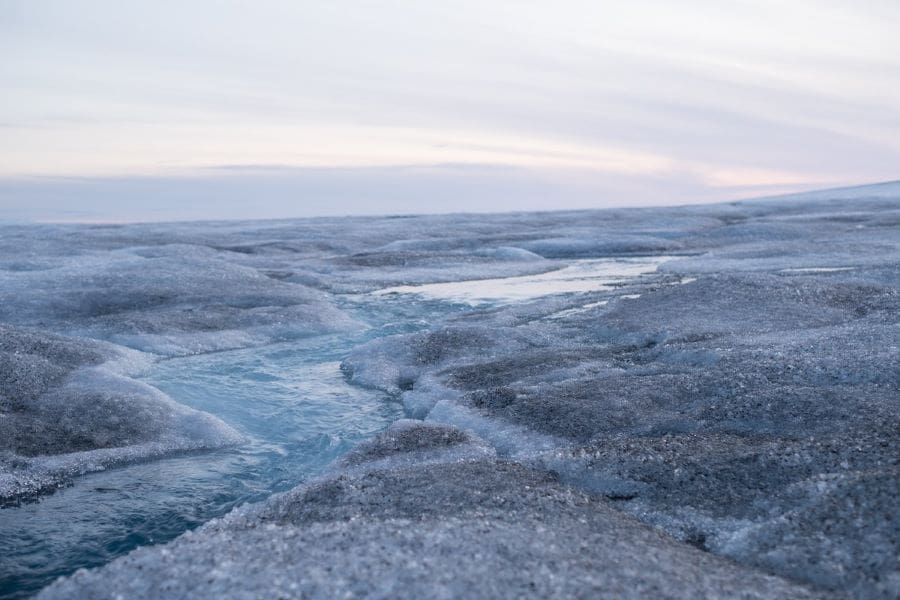
“New ice is being exposed on Greenland every year, because the snow melts earlier and earlier. There used to be a thick snow cover all year round, but now large new areas of ice are being exposed to the sun. This opens up these areas for the algae to colonize and as they can live on very limited amounts of nutrients it might happen sooner than later.”
Laura Halbach’s discoveries are not only fascinating but also important, because the knowledge on the algae’s nutrient requirements can help us to better predict their future role in the melting of the Greenland Ice Sheet. Today microbes are not yet integrated into most Earth climate models.
These new discoveries will hopefully be included in the climate models, making them more precise in predicting the melting of the ice in the years to come – and how it will impact the global climate.
***
The study is part of the project DeepPurple which has received funding from the European Research Council (ERC) under the European Union’s Horizon 2020 research and innovation programme. Aarhus University Research Foundation, the Max Planck Society, The Helmholtz Recruiting Initiative and the Agence Nationale de la Recherche has also contributed.
Journal Reference:
Halbach, L., Kitzinger, K., Hansen, M. et al., ‘Single-cell imaging reveals efficient nutrient uptake and growth of microalgae darkening the Greenland Ice Sheet’, Nature Communications 16, 1521 (2025). DOI: 10.1038/s41467-025-56664-6
Article Source:
Press Release/Material by Jeppe Kyhne Knudsen | Aarhus University
Melting glaciers increase loss of freshwater resources and rise global sea levels
Separate from the continental ice sheets in Greenland and Antarctica, glaciers covered an area of 705,221 km2 and contained 121,728 billion tons of ice globally in 2000. Since then, glaciers have lost about 5% of their ice globally, and regionally between 2% on the Antarctic and Subantarctic Islands and 39% in Central Europe.
Annually, glaciers lost 273 billion tons – 273,000,000,000,000 kg – of ice, with an increase of 36% from the first (2000−2011) to the second (2012−2023) half of the period. Glacier mass loss is about 18% larger than the loss from the Greenland Ice Sheet and more than twice that from the Antarctic Ice Sheet.
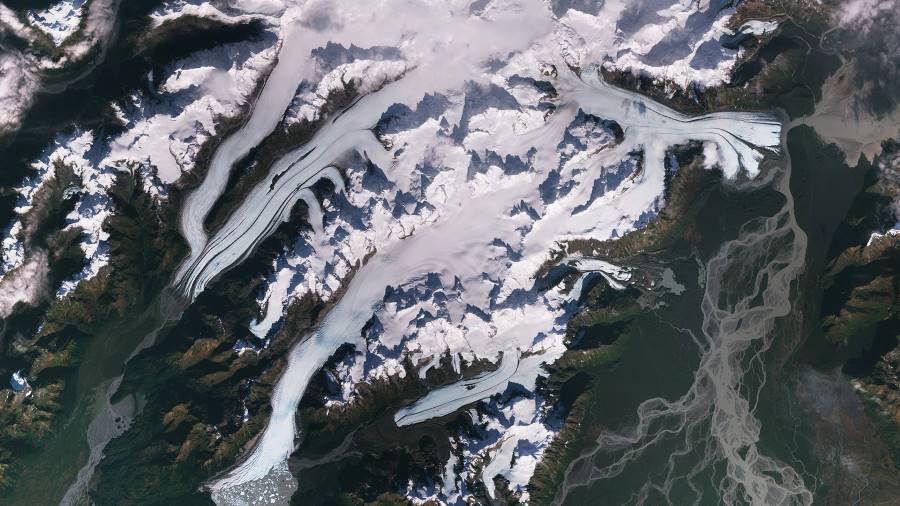
Worldwide research community effort
For the new study, an international research team under the coordination of the World Glacier Monitoring Service (WGMS), hosted at the University of Zurich (UZH) in Switzerland, carried out the so-called Glacier Mass Balance Intercomparison Exercise (GlaMBIE). The research community collected, homogenized, combined, and analyzed glacier mass changes from different field and satellite observation methods. The team then compared and combined the results from the different methods into an annual time series of glacier mass changes for all glacier regions in the world from 2000 to 2023.
The researchers compiled 233 estimates of regional glacier mass changes from about 450 data contributors organized in 35 research teams. “By combining the advantages of the different observation methods, GlaMBIE provides not only new insights into regional trends and year-to-year variability. We could also identify differences among observation methods, which is an opportunity to better understand and improve future estimates,” says Michael Zemp, UZH professor at the Department of Geography, who led the study.
Sinking regional freshwater resources, rising global sea levels
From 2000 to 2023, the global glacier mass loss totals 6,542 billion tons. This loss contributed 18 mm to global sea-level rise at an annual rate of 273 billion tons or 0.75 millimeters yearly. With this, glaciers are currently the second-largest contributor to global sea-level rise, after the warming of the ocean and before the contributions from the Greenland Ice Sheet, changes in land water storage, and the Antarctic Ice Sheet.

In addition, glacier melt results in the loss of regional freshwater resources. “To put this in perspective, the 273 billion tonnes of ice lost in one single year amounts to what the entire global population consumes in 30 years, assuming three litres per person and day,” states Zemp.
“Glaciers are vital freshwater resources, especially for local communities in Central Asia and Central Andes, where glaciers dominate runoff during warm and dry seasons,” says UZH glaciologist Inés Dussaillant, who was involved in the GlaMBIE analyses. “But when it comes to sea-level rise, the Arctic and Antarctic regions with their much larger glacier areas are the key players. Almost one quarter of the glacier contribution to sea-level rise originates from Alaska,” she adds.
Limiting negative effects through climate protection
The present study marks an important milestone for the International Year of Glaciers’ Preservation in 2025 and the Decade of Action for Cryospheric Sciences (2025−2034) declared by the United Nations. GlaMBIE provides a new observational baseline for future studies, allowing improved projections of freshwater resources and sea-level rise.
“Our observations and recent modelling studies indicate that glacier mass loss will continue and possibly accelerate until the end of this century,” says UZH glaciologist and GlaMBIE project manager Samuel Nussbaumer. “This underpins Intergovernmental Panel on Climate Change’s call for urgent and concrete actions to reduce greenhouse gas emissions and associated warming to limit the impact of glacier wastage on local geohazards, regional freshwater availability, and global sea-level rise,” he concludes.
***
The GlaMBIE Team
Michael Zemp, Livia Jakob, Inés Dussaillant, Samuel U. Nussbaumer, Noel Gourmelen, Sophie Dubber, Geruo A, Sahra Abdullahi, Liss Marie Andreassen, Etienne Berthier, Atanu Bhattacharya, Alejandro Blazquez, Laura F. Boehm Vock, Tobias Bolch, Jason Box, Matthias H. Braun, Fanny Brun, Eric Cicero, William Colgan, Nicolas Eckert, Daniel Farinotti, Caitlyn Florentine, Dana Floricioiu, Alex Gardner, Christopher Harig, Javed Hassan, Romain Hugonnet, Matthias Huss, Tómas Jóhannesson, Chia-Chun Angela Liang, Chang-Qing Ke, Shfaqat Abbas Khan, Owen King,
Marin Kneib, Lukas Krieger, Fabien Maussion, Enrico Mattea, Robert McNabb, Brian Menounos, Evan Miles, Geir Moholdt, Johan Nilsson, Finnur Pálsson, Julia Pfeffer, Livia Piermattei, Stephen Plummer, Andreas Richter, Ingo Sasgen, Lilian Schuster, Thorsten Seehaus, Xiaoyi Shen, Christian Sommer, Tyler Sutterley, Désirée Treichler, Isabella Velicogna, Bert Wouters, Harry Zekollari & Whyjay Zheng
Journal Reference:
The GlaMBIE Team, ‘Community estimate of global glacier mass changes from 2000 to 2023’, Nature (2025). DOI: 10.1038/s41586-024-08545-z
Article Source:
Press Release/Material by University of Zurich
New study links dust storms to increased emergency department visits in the U.S. Southwest
A new research study highlights the significant health risks associated with dust storms, revealing an increase in emergency department (ED) visits for respiratory and cardiovascular conditions, as well as motor vehicle accidents, in three Southwestern U.S. states.
The study, which was led at National Jewish Health was published in JAMA Network Open.
Researchers at National Jewish Health, Emory University and the University of Colorado analyzed over 33,500 ED visits across Arizona, California and Utah from 2005 to 2018.
The findings indicate that dust storms are associated with a heightened risk of asthma, culture-negative pneumonia, chronic obstructive pulmonary disease, congestive heart failure, ischemic heart disease, cerebrovascular disease and motor vehicle accident admissions on the day of the storm or the days immediately following.
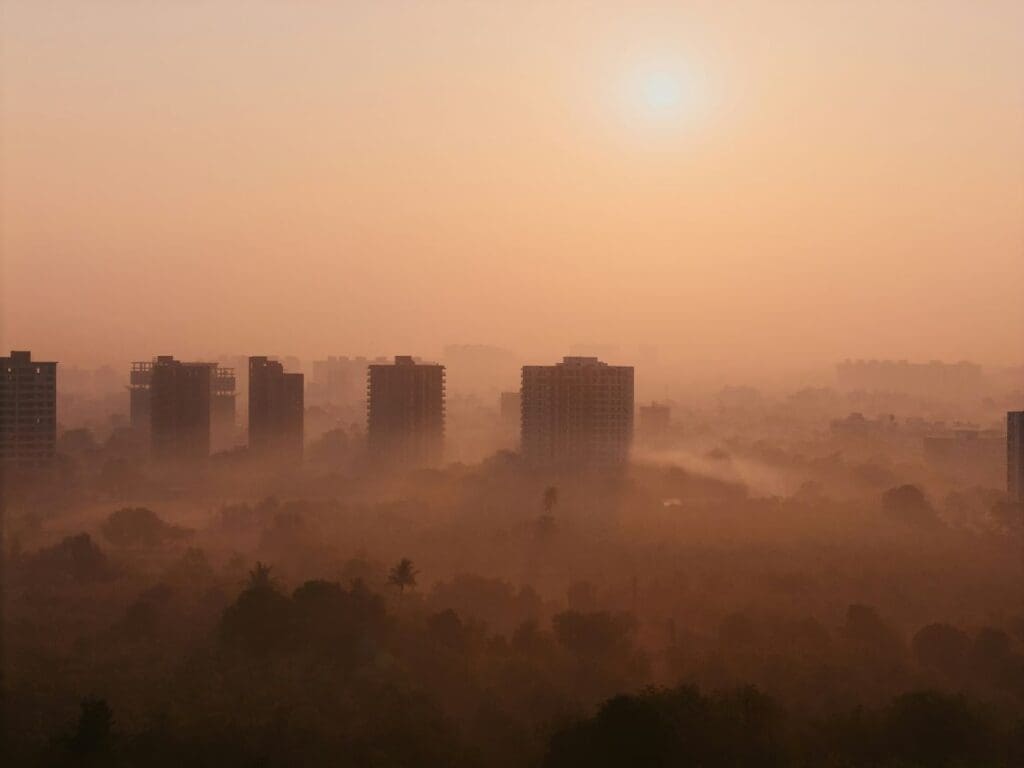
The findings support the growing body of evidence that dust storms are dangerous, not only for drivers but also for people with chronic health conditions.
“Dust storms are expected to become more frequent due to climate change, so it’s crucial that we understand their immediate and long-term health impacts,” said James Crooks, PhD, associate professor at National Jewish Health and senior author on the study. “Our study provides important data for public health officials to develop strategies aimed at reducing dust storm-related health risks.”
Key findings of the study include:
- A 6% increase in ED visits for asthma in the two days following a dust storm.
- A 6% rise in ED visits for culture-negative pneumonia and congestive heart failure in the week following a storm.
- A 13% increase in motor vehicle accidents on the day of a dust storm.
The study, which utilized National Weather Service storm reports and patient-level ED records, emphasizes the need for improved warning systems and public awareness initiatives to mitigate dust storm-related health impacts.
“Given the expected rise in dust storms, policymakers and health officials must take proactive measures to safeguard vulnerable populations,” said Dr. Crooks.
***
The research was supported by the National Institute of Environmental Health Sciences.
National Jewish Health is the leading respiratory hospital in the nation. Founded in 1899 as a nonprofit hospital, National Jewish Health today is the only facility in the world dedicated exclusively to groundbreaking medical research and treatment of children and adults with respiratory, cardiac, immune, and related disorders. Patients and families come to National Jewish Health from around the world to receive cutting-edge, comprehensive, coordinated care.
Journal Reference:
Zheng X, Chang HH, Ebelt ST, D’Souza R, Hohsfield K, Crooks JL. ‘Dust Storms and Emergency Department Visits in 3 Southwestern States Using NWS Storm Reports’, JAMA Network Open 8 (2): e2457666 (2025). DOI: 10.1001/jamanetworkopen.2024.57666
Article Source:
Press Release/Material by National Jewish Health
Featured image credit: Gerd Altmann | Pixabay

